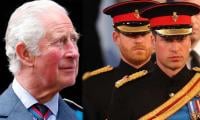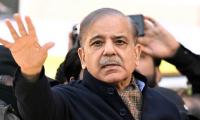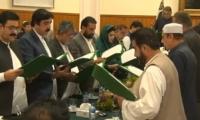LAHORE
Ashura, the 10th of Muharram, was observed with traditional religious solemnity and devotion on Wednesday, amidst strict security measures like a ban on mobile phones in sensitive areas and pillion riding etc, to commemorate the martyrdom of Hazrat Imam Hussain (RA) and his companions at Karbala in 61 AH, some 14 centuries ago.
In Lahore, the authorities clamped what could be called as exemplary security arrangements to ward off any terror threat and maintain safety and peace amidst intelligence reports of possible terrorist strikes. Luckily, the central Zuljanah procession and others remained peaceful in Lahore despite some fears that gripped the mourners and administrations due to terror threats in some major cities like Rawalpindi, Multan, Gujranwala, Karachi, Quetta, Peshawar and other parts of the country.
The suspension of mobile phone service is now becoming a regular security measure for the last couple of years besides other security arrangements, as the PML-N government followed suit PPP interior minister Rehman Malik in taking the measure. Though it caused problems for the masses in general and participants in the procession in particular, yet leaders of the Shia community appreciated it, hoping it would go well to keep the community safe during its biggest religious activity of the year. This year, the mobile phone service was not fully suspended but it was done on specific locations and areas from where mourning processions were to pass or the areas declared sensitive.
The district administration managed security by taking some new measures, the most effective of them was closing down both sides of the procession route and only allowing the mourners to enter after having their ID cards checked. Nobody was allowed to join the procession without which everyone was refused entry. These measures were in addition to the traditional security arrangements including army helicopters kept monitoring the procession while the special police squad moved ahead of the procession, kept checking and clearing the route before allowing it to proceed further. This procedure delayed the procession for about three to four hours behind the time initially scheduled for it to reach its destination, Karbala Gamay Shah. Various Zuljinnah, Alam and Tazia procession were taken out from different parts of the city which marched from their traditional routes before joining the central Zuljinnah procession. All markets and businesses were closed while press issued special supplements and electronic media aired special programmes to mark the significance of the event.
The central Zuljinnah procession which emerged from Nisar Haveli inside Mochi Gate on Tuesday night, passed through its traditional route and culminated at Karbala Gamay Shah near Data Darbar on Wednesday night. The procession was behind its schedule because of tight security as it was stopped for a security check at several places causing delay.
The procession passed from its route including Mohallah Chehel Bibian Imambargah Syed WAjid Ali Shah, Lakkar Mandi, Imambargah Mehdi Shah, Mobarak Haveli, Chowk Nawab Sahab, Kuch Qazi Khan, Imambargah Molvi Feroze Ali, Kucha Miskinan, Mohallah Pir Gilanian, Imambargah Rajab Ali Shah, Chohata Mufti Baqar, Chowk Purani Kotwali, Kashmiri Bazar, Sunehri Masjid, Dabbi Bazar, Suha Bazar, Gumti Bazar, Said Mitha Bazar, Tehsil Bazar, Bazar Hakiman, Unchi Masjid and Bhaati chowk. In their tough security measures the authorities deployed over 20,000 personnel belonging to different branches of law enforcing agencies including Rangers and FC to monitor and guard all the sensitive areas particularly the routes of the Zuljinnah procession. Policemen were deployed all along the route of the main Zuljinnah procession and were also taking positions at the rooftops of the building along both sides to monitor the procession. Police had closed the route of the main Zuljinnah procession from both sides with barbed wires and subjected everybody to thorough body search with metal detectors before allowing in to join the procession. Besides, special gates for scanning explosives and weapons were also placed at different entry points. Army and police helicopters kept taking rounds of the city skies to monitor the situation. Rangers vehicles kept patrolling the city streets. The residents of the buildings along the route were barred from opening their windows and coming to roofs but women and children were allowed to watch the procession from windows.
A large number of chest-beating and elegy reciting mourners participated in the procession and they also held Matam with chained knives at several points on the route. A number of Sabeels of juices, milk and cool water were set up mostly by Sunnis along the route to facilitate the mourners. Besides, a number of banners calling for Shia-Sunni unity were erected by different political leaders, electoral candidates and office bearers of district government.
The town administrations of Data Town put up extra lights along the route which not only brightened the area but also provided a sense of security to the participants, particularly in the night, as the light would enable people to identify any miscreant besides helping security personnel in maintaining law and order. Town officials and other office bearers also kept inspecting the situation at different points of the route to ensure peace.
Various social welfare organisations and volunteers provided first aid services to the wounded mourners as hundreds of them were provided first aid at the spot while about fifty seriously wounded were taken to different city hospitals in waiting ambulances for better treatment.
After the culmination of the procession, Majlis-e-Sham-e-Ghariban was held inside Karbala Gamay Shah in which zakerin highlighted the importance of the sacrifice by Hazrat Imam Hussain (AS).
This image released on September 12, 2023, shows a general view of the University of Management and Technology. —...
Punjab Youth Affairs Minister Malik Faisal Ayub Khokhar gestures during a meeting on March 11, 2024. —...
This photograph shows a Pakistani paramedic checking a child at a telemedicine online treatment centre in Pakistan....
Provincial Minister for Agriculture Ashiq Hussain Kirmani gestures during a meeting and Punjab Agriculture Secretary...
People buy pulses and grains at a wholesale market. — AFP/File LAHORE: Pakistan’s economy will grow at a rate of...
Lahore Development Authority’s Director General, Tahir Farooq presides over first meeting on March 9, 2024. —...







